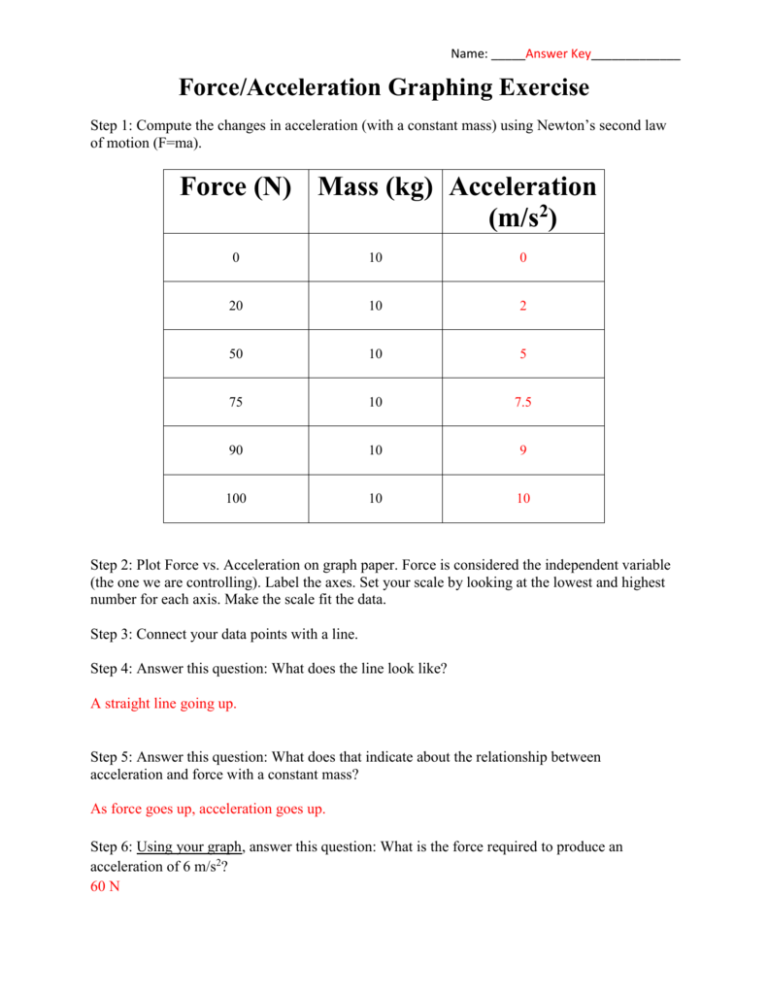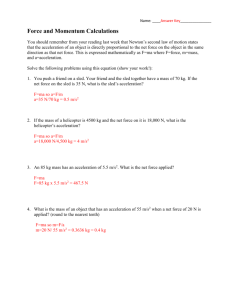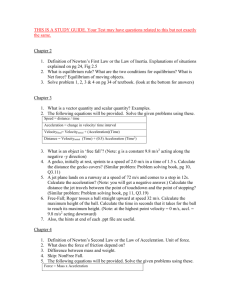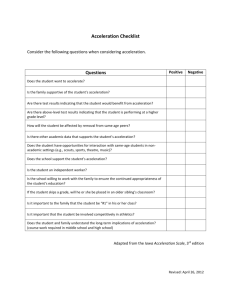Motion and Momentum Graphing Exercise-Answer
advertisement

Name: _____Answer Key_____________ Force/Acceleration Graphing Exercise Step 1: Compute the changes in acceleration (with a constant mass) using Newton’s second law of motion (F=ma). Force (N) Mass (kg) Acceleration (m/s2) 0 10 0 20 10 2 50 10 5 75 10 7.5 90 10 9 100 10 10 Step 2: Plot Force vs. Acceleration on graph paper. Force is considered the independent variable (the one we are controlling). Label the axes. Set your scale by looking at the lowest and highest number for each axis. Make the scale fit the data. Step 3: Connect your data points with a line. Step 4: Answer this question: What does the line look like? A straight line going up. Step 5: Answer this question: What does that indicate about the relationship between acceleration and force with a constant mass? As force goes up, acceleration goes up. Step 6: Using your graph, answer this question: What is the force required to produce an acceleration of 6 m/s2? 60 N Force vs. Acceleration 10 Acceleration (m/s2) 8 6 4 2 0 0 10 20 30 40 50 Force (N) 60 70 80 90 100 Mass/Acceleration Graphing Exercise Step 1: Compute the changes in acceleration (with a constant force) using Newton’s second law of motion (F=ma). Force (N) Mass (kg) Acceleration (m/s2) 50 1 50 50 3 16.7 50 10 5 50 12 4.2 50 20 2.5 50 25 2 Step 2: Plot Mass vs. Acceleration on graph paper. Mass is considered the independent variable. Label the axes. Set your scale by looking at the lowest and highest number for each axis. Make the scale fit the data. Step 3: Connect your data points with a line. Step 4: Answer this question: What does the line look like? A line curving down to the right. Step 5: Answer this question: What does that indicate about the relationship between acceleration and force with a constant mass? As mass goes up, acceleration goes down. Step 6: Using your graph, answer this question: What is the acceleration produced with a mass of 18 kg? ~3 m/s2 Mass vs. Acceleration 50 45 Acceleration (m/s2) 40 35 30 25 20 15 10 5 0 0 5 10 15 Mass (kg) 20 25 Momentum Graphing Exercise Step 1: Compute the changes in momentum (with a constant velocity) for objects of different masses using the equation p=mv (where p is momentum, m is mass, and v is velocity). Mass (kg) Velocity (m/s) Momentum (kg∙m/s) 0 5 0 3 5 15 5 5 25 8 5 40 15 5 75 30 5 150 Step 2: Plot Mass vs. Momentum on graph paper. Mass is considered the independent variable. Label the axes. Set your scale by looking at the lowest and highest number for each axis. Make the scale fit the data. Step 3: Connect your data points with a line. Step 4: Answer this question: What does the line look like? A straight line going up. Step 5: Answer this question: What does that indicate about the relationship between momentum and mass with a constant velocity? As mass goes up, momentum goes up. Step 6: Using your graph, answer this question: What momentum is produced with a mass of 22 kg? 110 kg∙m/s Mass vs. Momentum 150 140 130 120 Momentum (kg m/s) 110 100 90 80 70 60 50 40 30 20 10 0 0 5 10 15 Mass (kg) 20 25 30






